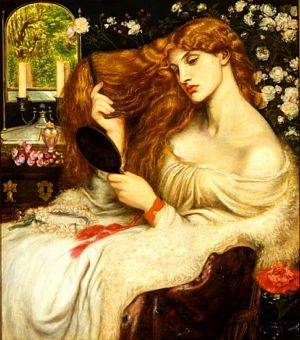Rossetti's 'For Our Lady of the Rocks": An Examination of Pre-Raphaelite Beliefs
Vilayath and Lance
|
In Rossetti’s ekphrastic art based off of Leonardo Da
Vinci’s, one may be able to view many processes being shown. For one thing, the
content on display in Da Vinci’s art is co-opted by Rossetti, who draws an
arguably different inspiration from the content than either Leonardo or any of
his contemporaries may have either intended or gotten from the painting. The
Madonna was a revered and holy biblical figure, a cherished image that gave a
chaste, impossible birth to the Messiah, which was a happy and wondrous
miracle. Rossetti’s gaze, however, morphs these impressions, and results in his
wording of the Madonna as being a sad person, a figure caught in a sort of
underworld, suffering forever in this picture under the gaze of what he
considers an “occult”. Rossetti’s twists the meaning of Heaven, changing it
into merely a “long day”, a pessimistic view of what Christians hold dear as
being salvation. To Rossetti, Christ lays his blessings “silently”, because he
is victim to the same vices, foibles, and human faults as the rest of humanity.
“Even Jesus would get bored of eternity,” Rossetti seems to be conveying.
Indeed, one should note how the tone of Da Vinci’s work changes before and
after the impressions laid out in Rossetti’s sonnet. |

Leonardo da Vinci
Self-Portrait
|
|
Another process at work here is the laying out for the foundation of what the Pre-Raphaelite Brotherhood meant to set out on in their collective work. At the time, Rossetti was merely in the beginning stages of setting out what it was he wanted to accomplish, and would one day join other of his contemporaries in attempting to materialize. This purpose, as is hinted at in the sonnet, was a concept that would endure throughout the period of the Pre-Raphaelite Brotherhood. The focus of Dante Gabriel Rossetti, along with the other artists in the Pre-Raphaelite Brotherhood, was on the paradigm of beauty and morbidity. This was a feature that can be seen in various works by this group of artists, such as Ophelia by John Everett Millais and Lady Lilith by Rossetti. The former painting, of a drowned lady awash in murky waters, was an attempt by Millais to capture how a woman could still be beautiful, perhaps even more so, in death. This is an example of trying to bring beauty to a normally disturbing, unpleasant concept: death. Rossetti’s painting of Lady Lilith, on the other hand, is of a woman who is brushing her hair. The lady herself is, according to mythology, the first woman to appear to the biblical figure of Adam, but was cast away when her evils nearly destroyed him. This is another example of how the Pre-Raphaelites tried to make a comparison between the beautiful and the morbid. In many cases, it was the beauty of form that uplifted the morose material. In other cases, it was the sad, longing brushwork that altered normally picturesque or beautiful content into a more hushed response from the audience. |


